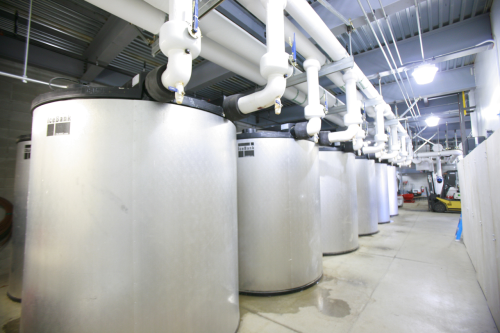FAIR LAWN When temperatures rise, so does electricity usage, as the drone of air conditioners and chillers becomes constant.

And with more power, comes higher power bills.
A Fair Lawn company is trying to change that by using ice. Calmac, based in Fair Lawn, uses its IceBank technologyessentially giant ice tanksto shift electricity usage from during the day, when its most expensive, to night, when its cheaper.
Instead of using electricity to cool buildings during the day, Calmac uses it to create ice at night. Instead of using an electricity-intensive chiller during the day, the ice is used to cool the air.
Most big buildings use chillers that circulate cold water through air duct coils to cool the air flowing through them. Calmac instead uses chillers to freeze water inside its tanks. During the day, the chiller turn off and a pump circulates water through the ice tanks and into the air ducts.
Its a 100-to-1 reduction in how much energy we need on peak to cool our space, CEO Mark MacCracken said.
Thats because electricity costs bout half as much at night, he said.
While ice storage can help reduce the cost of electricity, it also works well with greener sources of power, particularly wind energy, MacCracken said. Wind is mainly blowing at night, when electricity usage is low, and ice is an easy way of storing that energy, he said.

Using ice can also reduce dependence on dirtier forms of energy, Lynn F. Stiles, a professor emeritus of physics at Richard Stockton College and specialist in green energy, said. During peak times, utilities traditionally call on older, less efficient gas or coal plants to bolster the power supply. At night, utilities can rely on their more efficient base load generators, he said.
So why isnt there an ice tank in the basement of every building? MacCracken said many designers tend to stick with the simplest solution: Put in a big chiller and forget about it.
They sense [ice storage] being a little more complicated and theyre not getting paid any more for it, he said.

And while ice storage may save money over time, many building owners are more sensitive to up-front costs, Stiles said.
It suffers from the same problem as any energy efficiency technology tends to suffer from in our society, and that is the payback period for the investment is often longer than what the investors want, he said.
Energy storage also doesnt receive the same level of government support as solar and wind power. New York and Con Edison launched an incentive program for energy storage in May, but a similar program in New Jersey is still under discussion.

Still, Calmac has 4,000 installations in 37 countries, including its own building in Fair Lawn and the Ansfield School of Business at Ramapo College. The technology works especially well in schools, which generally stop using power after 3 p.m.
Calmac estimates it saves clients about 40 percent on cooling costs, though the company declined to offer real-world figures. Ramapo also did not offer specifics on how much it saves.
MacCrackens father, Calvin D. MacCracken, founded Calmac in 1947. The company began working in thermal energy storage in the 1980s, and watched as it came in vogue in the 90s, then out of vogue with the deregulation of utilities, then back in vogue in the 2000s as the green building movement grew.

I think were on the cusp of a pretty big ramping up on energy storage, MacCracken said. Were still not in a major portion of buildings. Weve only scratched the surface.
Correction: The Calmac CEO's name is Marc MacCracken, not McCracken.
Source |